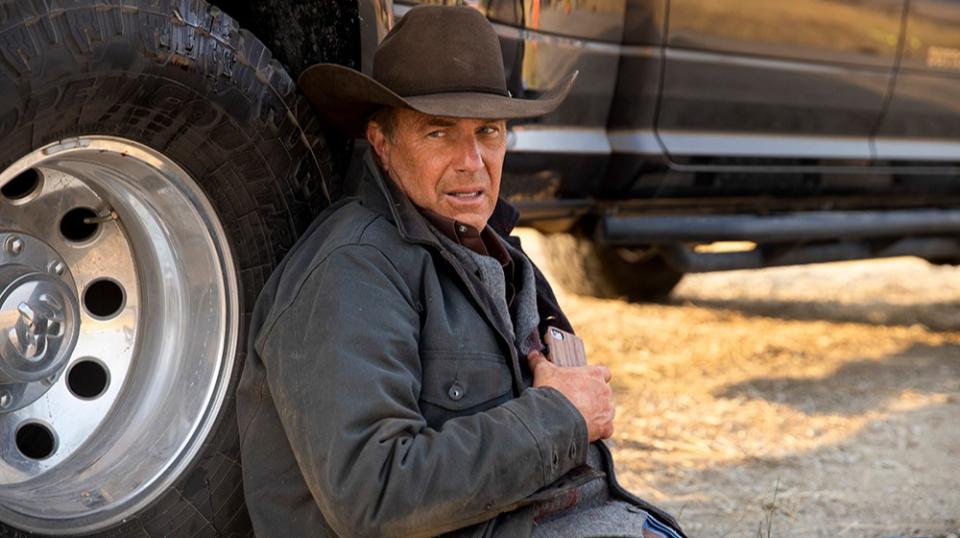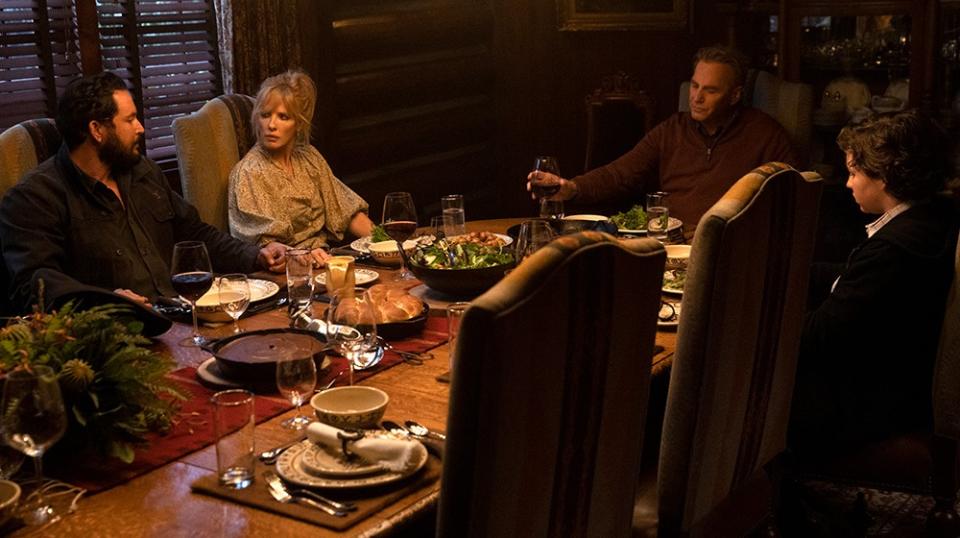From Warring Ranchers to Squabbling Vampires, Samuel Ejnes and Diego Gat Make it All Sound Real

- Oops!Something went wrong.Please try again later.
Fans of “Yellowstone” have come to expect viscerally charged action tied to the Dutton family’s intense emotional and political entanglements. But even by those standards, the opening sequence of Season 4 is a game changer: The episode begins with three main characters targeted for assassination in a 13-minute shootout and chase that incorporates almost all of the series’ principals in an impeccably orchestrated, steadily escalating explosion of violence. In its relentlessness, immediacy, and clear and concise expression of character through action, it’s the closest television has ever come to the bank robbery at the center of Michael Mann’s “Heat.”
Contributing to the opening’s impact is its sound design, characterized — like every other component of the sequence — by a brutal authenticity punctuated by moments of lyrical impressionism. In its complexity, ambition, and overall effect, the set piece is a culmination for re-recording mixers Samuel Ejnes and Diego Gat, who have been working together since 2017 on shows as varied as “Mythic Quest,” “Black Monday,” and “Atlanta.” Television schedules are notoriously unforgiving, but Ejnes and Gat have managed to bring the nuance and auditory complexity of the best feature films to their work.
More from IndieWire
“I always feel like the term ‘sound mixer’ understates what Diego and Sam do, and what makes them so great,” said “What We Do in the Shadows” and “Atlanta” executive producer Paul Simms. “Just as the production designer and the DP design the look of the show, [Diego and Sam] are really designing the sound and the tone of it — and adding a lot of funniness that viewers would never know was not planned from the very beginning. And as their work is the last step in the process, you can really feel a cut that you’ve probably watched 30 times in editing suddenly come to life and feel brand new when they work their magic on it.”

Paramount Network
Ejnes and Gat have found that their similar tastes and easy communication have produced pleasing results. “I do sound effects and foley and backgrounds, and Diego focuses mostly on the music and dialogue,” Ejnes said, “but we’re not afraid to give each other notes or ideas.” Ejnes came to sound design through music, playing trumpet in his school band and working as a DJ before learning in college that there was “this thing called post-production” and moving out to L.A. to work in the film business. Gat worked in live theater in his home country of Argentina and started mixing movies in film school; six years ago he moved to Hollywood and met Ejnes, with whom he has been working ever since.
“We’ve developed a common way of doing things that makes things a lot smoother” Gat said. “It’s unspoken communication — we just look at each other and know what the other one is thinking most of the time.” Their ability to swiftly and clearly communicate was essential when it came to that “Yellowstone” premiere: “The note that we were given was, ‘We want the cold open of the show to grab the audience by the face and throttle them until the main title starts,’” Ejnes said. Initially, he and Gat mixed the sequence in a more orthodox manner, balancing the music and effects and leaving pauses where music would dip down to make room for dialogue. But the producers wanted the mix to be a persistent assault with no let-up.
“We had to keep the music up and not dip for sound effects, just let the sound effects bulldoze over the music,” Gat said. “We had to keep the sound pressure on at all times, so when we did dip it had to be very detailed, working note by note. It took a very long time. Very detailed frame by frame mixing.” They added layer upon layer to the sound mix: Bullet hits, tire screeches, bone breaks, dialogue that’s crisp and clear but not unbelievably louder than the surrounding commotion, music that weaves in and out with a hypnotic power. Even Ejnes felt tense watching the footage on the final review. “It’s something like 14 minutes of action before the main titles coming in, and you realize when those titles start that you’ve been holding your breath,” he said.

Paramount Network
Part of what makes “Yellowstone” as a whole so successful is its sense of realism, an approach that informs all of Ejnes and Gat’s choices on the mix stage. “We’re always trying to keep it very authentic and real,” Ejnes said. “There might be moments that are more design-y and fun, but for the most part it’s just about presenting what’s happening in the scene. There’s always the urge to make the guns big and sound like an action movie, and sometimes we do, but for the most part we want to keep it within the world and contained. And we’re also mindful not only of what we hear, but of what we don’t hear.”
Gat added, “If we’re in a house, we think about how thick the windows are. Can we hear the rain on the other side of the window? When we close a door, does it seal well enough that we don’t hear the rain, or do we still hear some? There are a lot of conversations about footsteps – like, even if we don’t see the floor, we know the last two footsteps were on a rug, so we want that sound. It’s that kind of detail.”
These are guiding principles shared by two of Ejnes and Gat’s other recent credits: the “Yellowstone” prequel “1883” and the supernatural mockumentary “What We Do in the Shadows.” The period setting of the former presents some unique challenges, particularly for Gat — “From a dialogue perspective, there’s a lot more cleaning. You can’t have a highway in the background, or a generator — while the latter deviates from every other show the duo mixes, in the practice of adding the types of sounds that other productions would strive to remove.
“We’ll come into a mix and say, ‘What would it sound like if that character wasn’t on a microphone?,’” said “Shadows” director and editor Yana Gorsaka. “Not to make it sound like we did it bad on purpose, but we’re always trying to make it sound like we recorded it as a documentary.”
Gat credits Ejnes with finding sound effects that add to the show’s humor. “There’s a way of making a body fall funny, and it can also not be funny,” he said. “It’s like, what about the materials? If it’s softer is it funnier? Is it funny if it feels like a soft body, or is it funnier if it’s harder and sharper and more painful? Would it be funnier if it’s two ‘plop plops,’ or should it be three parts or just one?” This speaks to their keen focus on rhythm. “One thing that we’ve learned over the years of working in comedy is that the making or breaking of rhythm can help heighten the humor of a situation,” Ejnes said.
In the video below, see how this seemingly counterintuitive approach, when combined with the imaginary noises of a supernatural world, amplifies the comedy of “What We Do In The Shadows.”
The mixers admit that the secret to comedy is relatively simple. “The trick is to lay back, let the brilliant writing and the incredible leads and guests on the show do their thing, and then find a point to heighten what we’re seeing and just push it a little bit.” For Ejnes, what keeps the job fun is its connection to his musical roots. “I approach it like a musical performance,” he said. “Finding the rhythm, finding the balance, trying to tell a story without saying anything. Taking all these disparate parts and mixing them down together to be a single soundtrack really speaks to me in a fulfilling way. That is unique. That is really special.”
Gat retains a similar sense of enthusiasm about his work, particularly in what he learns from the filmmakers with whom he collaborates. “They’re truly inspiring people,” he said. “I learn a lot from them and admire their capability to write, direct, work with actors…it never gets old.” Something else that never gets old for Gat is the technology he uses in his work. “Plug-in makers keep releasing new plug-ins and we need to use them,” he said. “There are always new toys to try. I still find the knobs on my console beautiful. It’s basically programming a computer to create something and tell a story. I’m still amazed by the faders moving by themselves and the computer doing what I taught it to do. I’ve been doing this quite a while, but it’s magical every time.” —Jim Hemphill
Best of IndieWire
The Best Survival Movies, from ‘Cast Away’ and ‘The Revenant’ to ‘The Martian’ and ‘Alive’
The 20 Best Spy Movies, from 'Enemy of the State' to 'North by Northwest'
Sign up for Indiewire's Newsletter. For the latest news, follow us on Facebook, Twitter, and Instagram.

